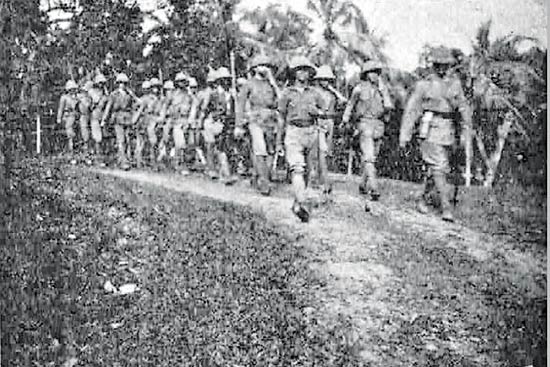Trinity’s long march to Colombo
A great feeling of patriotism gripped the people of Ceylon as war broke out between Britain and Germany in 1914. This was especially strong among the young men educated at the island’s Christian schools. As readers of these columns know, a large number of Ceylonese volunteered to fight for ‘King and Empire’, even though the conflict was thousands of miles away and did not threaten their homeland. Sergei De Silva-Ranasinghe, a military historian based in Australia, has counted 235 ‘Ceylonese’ who served in the war, in addition to the many British volunteers who had roots in the island.
An enterprising group of boys from the Cadet Corps of Trinity College, Kandy, led by their Senior Prefect Richard Aluwihare and several others who had recently graduated, came up with the idea of embarking on a route march to Colombo, a distance of 72 miles (115 km), to show their readiness for military service.

The TCK group at Veyangoda. Photo credit Amicus 1915.
On the 26th of November 1914, a group of 29 past students and a handful of teachers, including their charismatic Principal Rev. A.G. Fraser, set off from Trinity College at 4 p.m., intending to march all night and rest during the heat of the day. They were wearing their full kit, including rifles, and were accompanied by the College’s marching band until the Peradeniya bridge.
The group reached Kadugannawa in heavy rain at 9.30 p.m., continuing on to arrive at Kegalle at 1.20 a.m., where they rested for a short while. The trek was resumed, reaching Ambepussa at 7 a.m., where they finally got some sleep.
Five of the group dropped out due to health reasons, and the march was resumed at 3.30 p.m. reaching Veyangoda at 7.30 p.m., with the remaining marchers exhausted but in good spirits. Another young man was forced to drop out when the journey recommenced a few hours later. By now the group was very tired, so some equipment, including their rifles, was carried in the car that accompanied them.
In the full account of the march (in Amicus of January 8, 1915), the feeling was that they had all ‘bitten off a little more than (they) could easily chew’, but showing true grit, they pressed on. Singing songs and taking a short break every four miles (six km), the marchers resumed at 2.30 a.m., finally stopping for an exhausted sleep by the side of the road, in gentle rain, until 4 a.m.
The contingent finally reached the Victoria Bridge at Kelaniya at 6.30 a.m., where they had a much needed rest and ate a large breakfast to revive themselves. Setting off once more in good spirits and ‘trying to march as if (they) had just started’ (Amicus), the Trinity College contingent reached their goal, the Ceylon Light Infantry headquarters, at 9 a.m. on November 26th, 1914.
The entire contingent, including two of their teachers, Messrs Seneviratne and Campbell who accompanied them the whole way despite not being cadets, then volunteered to join the British Army. Legend has it that the Governor, Lord Chalmers, who was incidentally a Buddhist scholar of some repute, declined their request, instead exhorting them to remain and build Ceylon into a great country.
Sadly, the Governor’s words were prescient, as both his sons would be killed early the next year in the carnage on the Western Front, thereby breaking their father’s spirit. How this was to influence Lord Chalmers’ handling of the 1915 riots in Ceylon we can only speculate on.
Despite the Governor’s dissuasion, a group of lads who were of age decided to sail to England and volunteer. This group (see photo) included Richard Aluwihare (this writer’s grandfather), J. Loos, F. Drieberg, A. Rudra, A. Halangoda, D.B. Seneviratne and N.P. Campbell, the latter two being members of the College staff.
Frank Drieberg and Jas Loos were destined to make the ultimate sacrifice and are memorialised on the Kanatte gravestone that inspired this series of articles.
Searching for an ideal partner? Find your soul mate on Hitad.lk, Sri Lanka's favourite marriage proposals page. With Hitad.lk matrimonial advertisements you have access to thousands of ads from potential suitors who are looking for someone just like you.


